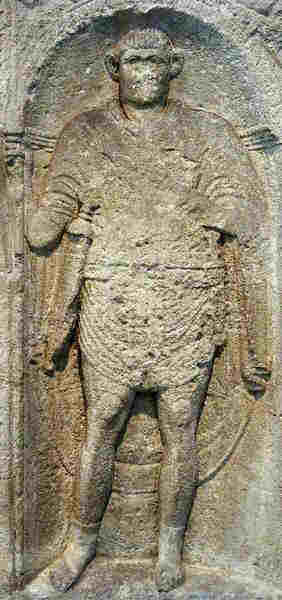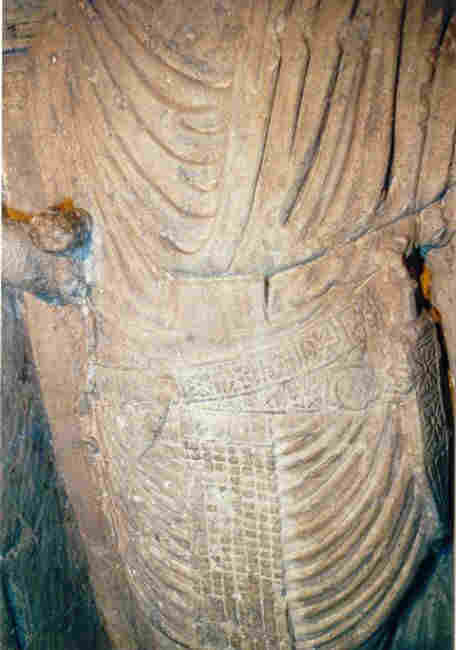|
| The reliability of provincial
sculpture as evidence |
Crispvs(Paul Geddes)
|
|
|
When I wrote my article on the carriage
of weapons I had already been testing the unbelted sword baldric,
as shown in sculpture, for some time. I knew the results from practical
experience, but I had not tested the position of the pugio as it is
seen in sculpture. As a number of serving and former soldiers in the
group have pointed out to me, a large dagger sheath resting against
the front of the leg would quickly become annoying when walking and
the preference would be to move it to the side. This was said from the
experience of wearing heavy ammunition pouches in this position.
However, this is where they are generally shown being
carried on funerary stelae. This gave me cause to become more wary about
the position of these pugiones shown in sculpture. It is true that there
are funerary sculptures which show pugiones worn at the side but rather
more show them at the front, which, as already noted, is not a very
practical position. A valid point can be made however, that this may
be to allow the pugio to be seen more easily by the viewer. This brings
me to the subject of the value of sculpture as evidence for the reality
of the past. The pitfalls of using Trajan's Column and the column of
Marcus Aurelius, along with various other well known pieces of urban
pubic sculpture, as evidence are already well known. However, provincial
sculptures and especially provincial funerary sculpture have normally
been held to be more accurate, the rationale being that not only do
they often seem to show details which are confirmed by archaeology,
but also that the sculptors who created them were clearly not trained
in the classical traditions of sculptural representation which can be
clearly seen in many pieces of urban public sculpture, particularly
in Rome but also to a lesser extent in Italy, Gaul, North Africa and
Asia Minor, and might therefore be expected to depict what they saw
rather than what they had been taught was the right way to depict a
particular thing. However, whilst we can learn a great deal from provincial
military sculpture and our knowledge of the Roman soldier would be so
much poorer without it, is what we see always reflective of reality?
What things might be the result of other factors?
Looking at provincial sculpture it can quickly
be seen that the sculptors did not necessarily feel the need to
be totally faithful to reality. The most obvious evidence for
this is that often the people shown in sculpture are very oddly
proportioned, with overlarge hands, unnaturally short legs, unusually
sized heads, unnaturally large waists, very big ears etc. (figs
1. & 2.).
|
| |
 Fig 1. Petilius Secundus.
Fig 1. Petilius Secundus. |

Fig. 2. Caecilius Avitius
|
|
|
Similarly, sword pommels are often depicted as being much larger
than would be expected in reality and seem to conflict with the
evidence of the length of surviving sword tangs. In addition to
this, there are some indications that the sculptor has 'tidied
up' the image slightly, so that, for example, we see aprons which
are hanging from diagonally worn belts which are perfectly level
at the bottom, so all of the apron terminals hang in perfect horizontal
alignment. Such a thing would be difficult to achieve in reality
so here we can see an example of a change made by the sculptor
to better suit his aesthetic values (fig. 3).
|
|
|
 Fig. 3. Detail of Firmus’ belt arrangement.
Fig. 3. Detail of Firmus’ belt arrangement. |
|
|
Similarly, we can sometimes see examples
of simplification, where achieving realistic detail was beyond
the sculptor's capability. Perhaps the clearest examples of this
simplification are in the depiction of belt plates and pugio sheaths.
In the case of type 'B' belt plates decorated with concentric
circles the detail is normally well produced, but in the cases
of type 'B' plates with more complex designs and type 'A' plates,
which normally feature intricate abstract designs, this level
of detail is difficult if not impossible to reproduce in stone.
Therefore, simplified designs are often featured on sculpture
which are not reflected in the evidence of the archaeological
record but can be understood as an achievable representation of
something which cannot be accurately represented in stone. The
same applies to the decoration shown on dagger sheaths: the decoration
found on the actual pieces is similarly complex and cannot easily
be achieved in stone. Like belt plate decoration therefore, this
decoration is normally either simplified or omitted so that sometimes
they appear superficially similar to the designs apparently shown
on belt plates (fig. 4).
|
| |
 Fig 4. Detail of Annaius Daverzus’ pugio
and belts.
Fig 4. Detail of Annaius Daverzus’ pugio
and belts. |
|
|
Attempts to compare the two from sculpture are
misguided though, as, according to a wealth of archaeological
evidence, what would be compared is extreme simplification of
the reality, not the reality itself. Any advantage which the original
painted surfaces would have given ancient viewers is lost to us.
It should also not be forgotten that in many of the places where
we might expect to see provincial sculpture, we know of existing
artistic traditions of formalisation or stylisation. This should
lead us to be suspicious therefore, that there might be other
things present in a particular sculpture which are as much the
result of formalisation and aesthetic taste as the result of empirical
observation. What other things, then, might be the result of 'tidying
reality up' to suit the sculptor's taste or skill? As we have
seen above, there is a strong suggestion that pugiones may have
been 'moved' by sculptors to positions where they would be more
visible from the front than they might be in the actual position
they were normally carried in. This must lead us to the suspicion
that there may, from time to time, be other items which have been
'moved' by a sculptor to allow them to be seen more easily. This
might include distortion, particularly of shafted weapons to allow
them to fit the available space. Another feature which may be
present but unnoticed in funerary sculpture may be symbolism which
displays aspects of the deceased's character. Looking at people
in terms of the moral or practical characteristics they displayed
was very common in ancient literature and in later mediaeval art
we see a very heavy emphasis in art on symbolism which allows
the art to transcend the purely visual and explore the moral,
cultural, and practical aspects of a person. Whilst what symbolism
which may be present on funerary stelae probably would not come
close to the comprehensive level of mediaeval symbolism, a primitive
symbolism may yet be present. Might particularly big ears represent
a reputation for having particularly good hearing, or has the
sculptor just given the figure large ears due to lack of attention
to proportion? Might large eyes represent a particularly keen
sighted or perhaps wise person, or could a sculptor used to Celtic
artistic styles have almost unconsciously incorporated something
of the large eyes often seen in Celtic art into the sculpture
he was now doing for patrons in the Roman army. Was the decision
for some soldiers to be represented in the act of dining (fig.
5) done for a moral purpose rather then a cultural purpose or
perhaps simply a stylistic preference? At the end of the day,
there is little we can do to see these sculptures exactly as their
original audience saw them, but as I hope has been shown by this
brief article, perhaps we should be more careful than we had previously
supposed with provincial sculpture when we use it to inform ourselves
about the Roman soldier.
|
| |
Fig. 4: Caius Iulius Baccus.
|
|
|
(All photographs used have been taken from the
Romanarmy.com imagebase)
|
|

